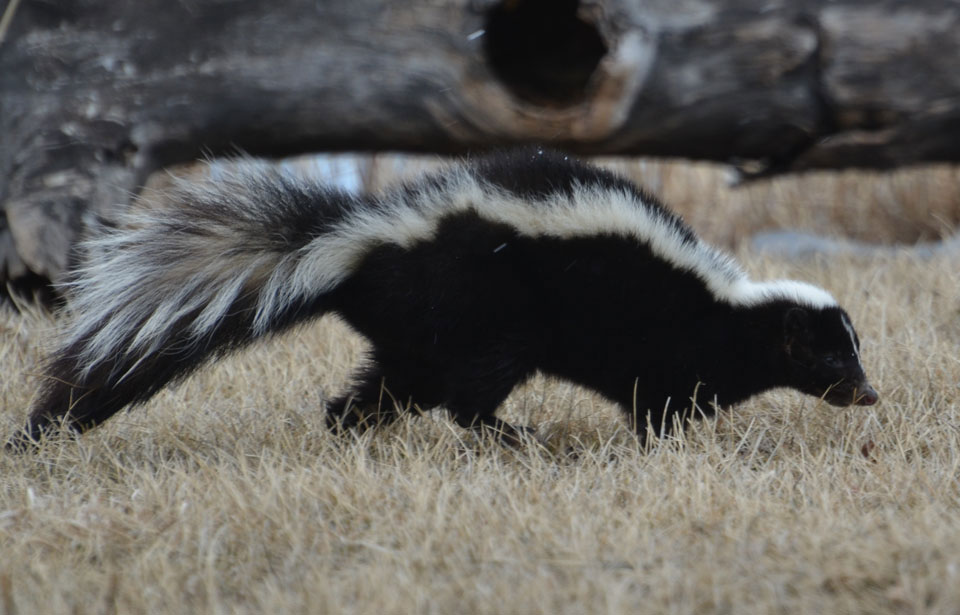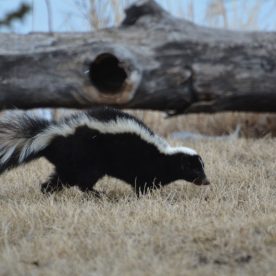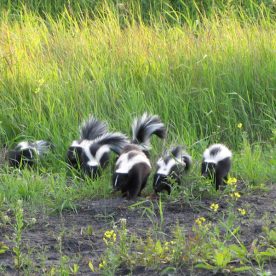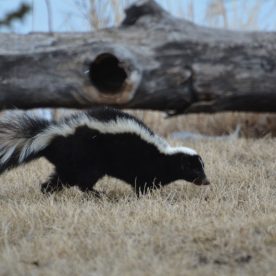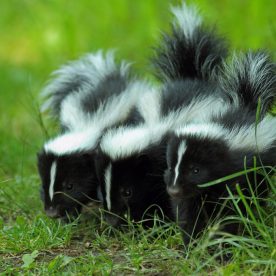Description
The striped skunk Mephitis mephitis is about the size of a cat, but has a stout body, a rather small head, short legs, and a bushy tail. Its small head fits conveniently, but sometimes too snugly, into enticing open jars.
The thick, glossy fur is black, with a thin white stripe down the centre of the face and a broad white stripe beginning on the back of the head, forking at the shoulders and continuing as a white stripe along each side of the back to the base of the tail. The tail is mostly black, but the stripes may extend down it, usually to a tuft of white at the tip.
The skunk has long, straight claws for digging out the burrows of mice, ripping apart old logs for grubs and larvae, and digging in the sand for turtle eggs. It moves slowly and deliberately and depends for safety not on running away or on remaining inconspicuous, but on its scent glands.
Skunks belong to the weasel family Mustelidae, all of whose members have well-developed scent glands and a musky odour. The skunk is outstanding for this characteristic, however, and can discharge a bad smelling fluid to defend itself. Indeed its scientific name, mephitis, is a Latin word meaning bad odour.
Signs and sounds
An angry skunk will growl or hiss, and stamp its front feet rapidly.
Habitat and Habits
The striped skunk is one of the most useful small mammals that inhabit the mixed farmlands, grasslands, and forests of Canada. Unlike many other animals it has adapted well to the presence of humans, and its present range is much expanded since primeval times.
The skunk prefers open areas of mixed forests and grasslands and has very little fear of humans, so it has benefited from the new habitats created by the opening of the forests that accompanied settlement and agriculture.
Skunks generally live in the abandoned dens of woodchucks, foxes, or other mammals of similar or larger size and only occasionally excavate their own dens. They will also use stumps, rock piles, or refuse heaps, or will even set up housekeeping under a house or porch or in a cellar. The latter practice is especially common in farming areas.
Skunks that den under buildings should be trapped outside. Never shoot them under the building. To dispose of unwanted or locally harmful skunks without harming them, box traps may be used. Such traps permit easy handling of the skunks and transportation to more suitable localities for release. Once the skunk is captured the trap may be covered with several burlap bags until it is transported some kilometres away and the skunk released. For information on obtaining such a trap, contact the local humane society.
If a skunk digs its own den it is usually simple, but one taken over from another animal may be quite elaborate. There may be from one to five well-hidden openings that lead to a system of tunnels and chambers. One of the chambers is lined with leaves and used for a nest. The leaves may also be used to plug the openings to the den in cold weather. A skunk gathers leaves by placing them under its body and then shuffling along to the den with the leaves held between its legs as it moves.
Skunks may leave their den to forage, or search for food, at any hour of the day, but are usually abroad from late afternoon or evening through the night. They forage within about 800 m of the den, but may venture as far away as 2 km in a night. Males become more active during the breeding season, when they may travel 8 km in a night.
By autumn skunks have acquired a heavy layer of fat, and in November or December they select a deep den in which to spend the winter. As many as 20 skunks have been found in one den, but the number is typically much fewer. Usually the mother and young den together, entering the den when the temperature reaches about 0° C.
Males are active until the temperature reaches about -10° C and may join their own family, other males, or may den alone. They may emerge briefly from their den at any time during winter. Any grouping of sex and age may be found together in a den.
By late February, in some parts of Canada, skunks begin to awaken from their winter state of torpor, or inactivity, and are fully active by the end of March. On the prairies and in the most northern parts of the range, spring emergence is somewhat later.
Unique characteristics
The scent of the skunk is produced by a thick, yellow, oily fluid, or musk, secreted by two glands located on either side of the anus at the base of the tail. The glands are about the size of a grape and contain about a tablespoon of musk, enough for five or six discharges. The glands are connected by ducts to two small nipples that are hidden when the tail is down and exposed when the tail is raised. The musk is produced rather slowly, at a rate of about one-third of an ounce a week, and is discharged only as a last desperate measure after repeated warning signals.
A skunk is not an aggressive animal and will always try to retreat from a human or other large enemy. An angry skunk will growl or hiss, stamp its front feet rapidly, or even walk a short distance on its front feet with its tail high in the air. The striped skunk cannot spray from this position. To perform that defence it usually humps its back and turns in a U-shaped position so that both the head and tail face the enemy. Many people used to the antics of the striped skunk have been deceived on their first encounter with a spotted skunk, which faces an attacker standing on its front feet with its back and tail arched forward.
The skunk directs the fluid from the glands in a stream that disperses into a fine spray. The spray can reach as far as 6 m and can be aimed with considerable accuracy for up to 3 m. The odour is strong enough to be carried almost 1 km on the wind. At close range the spray of a skunk causes severe smarting of the eyes and even nausea, but these symptoms soon disappear as the nasal passages quickly become desensitized to the odour.
Various remedies are recommended to get rid of the odour on clothing or dogs that have been sprayed by a skunk, but some of the remedies are almost as bad as the musk. Vinegar or a mixture of vinegar and detergent is a simple and quite effective treatment. The Ontario Ministry of Natural Resources suggests the following recipe:
1 l hydrogen peroxide
50 ml baking soda
5 ml dishwashing liquid
Skunks seem to be aware of the repulsiveness of their own odour and refrain from scenting on themselves. They therefore avoid musking in confined spaces, and their dens have little of the skunk odour about them.
Range
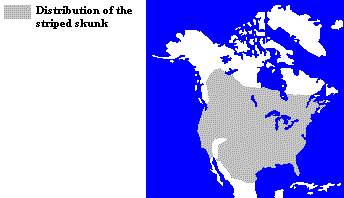 There are three groups of skunks represented by eight species in North America, but only two species occur in Canada. The striped skunk is the one familiar to most Canadians. Its range extends from central Mexico to Nunavut and the Northwest Territories and from the Maritimes to west-central British Columbia.
There are three groups of skunks represented by eight species in North America, but only two species occur in Canada. The striped skunk is the one familiar to most Canadians. Its range extends from central Mexico to Nunavut and the Northwest Territories and from the Maritimes to west-central British Columbia.
The hog-nosed skunks Conepatus are confined to the southwestern United States, Mexico, and South America; and the hooded skunk Mephitis macroura occurs in the southwestern United States and Mexico. Of the four species of spotted skunk Spilogale, the eastern spotted skunk Spilogale putorius almost reaches the Canadian border between Minnesota and Manitoba, but only the western spotted skunk Spilogale gracilis actually occurs in Canada. There are a few records of this skunk in southern British Columbia, but only as far as 120 km north of Vancouver.
Feeding
Skunks are truly omnivorous, eating a wide variety of foods. They eat insects, mice, shrews, ground squirrels, young rabbits, birds’ eggs, and various plants. During the autumn and winter they eat about equal amounts of plant and animal foods, but eat mainly insects in the summer. Skunks are especially fond of grasshoppers, crickets, and insect larvae such as white grubs, army worms, and cutworms. They will even eat wasps and bees, which they kill with their front feet. Although they annoy farmers by raids on beehives and henhouses, it has been estimated that almost 70 percent of a skunk’s diet is beneficial to people and only five percent is harmful to human property.
Breeding
Skunks begin to breed in late February or March, when they emerge from their dens, and the young are usually born in early May. There are typically four to six young in a litter, although the number may vary from two to 16.
Newborn skunks weigh about 15 g and, although almost naked at birth, show the characteristic black and white colour pattern of the adult. They are fully haired in about 13 days, and their eyes open after 17 to 21 days.
When the young skunks are approximately seven weeks old the female takes them out to search for food, and at about two months they are weaned, or have made the transition from the mother’s milk to other foods. They remain with their mother until autumn and may join her in the winter den.
Conservation
The scent of the skunk is an effective defence against most natural enemies. Nevertheless, it is preyed upon by bobcats and birds of prey. Most birds, especially hawks and owls, have developed the sense of sight at the expense of their sense of smell; the Great Horned Owl in particular seems relatively unaffected by the scent and has made the skunk its principal prey.
Trappers take 6 000 to 7 000 skunks a year in Canada, but this represents only a small fraction of the total skunk population and has no appreciable effect on numbers.
Motorists are a much greater hazard. Skunks, like porcupines, are overly confident of their defence mechanisms and often pay heavily for the air of unconcern with which they cross highways.
Although skunks may become a nuisance to poultry and bee keepers, the damage they inflict is not economically important and they are beneficial to agriculture. In fact, skunks proved such an efficient enemy of the hop grub in New York State that legislation was passed to protect the skunk. In many parts of their range they are the most important predator on insect pests.
The skunk is a furbearer of minor importance. Its fur, which is thick and lustrous, can be made into coats and jackets, but is used mainly for trimming. Most of the pelts marketed in Canada come from eastern Canada.
In the period following the First World War, when fur prices were high and unstriped black skunks were in great demand, various attempts were made to raise skunks on fur farms. If fur prices had remained at the level they reached during the boom, these ventures might have succeeded, but today the cost of raising a skunk is far more than the pelt is worth. The value of the skunk lies elsewhere. It is an interesting and attractive animal that plays a significant part in nature, especially as a predator of mice and insects.
Skunks are major carriers of the rabies virus, to which all warm-blooded animals, including humans, are susceptible. The occurrence of rabies is a continuing problem in many parts of Canada. Skunks may transmit the disease to other wildlife, livestock, and humans and propagate it among their own kind. Although skunks will normally retreat from a person, the rabid animal will often show no fear. Children in particular should be warned against handling over-friendly skunks.
Medical authorities recommend that a person who comes into contact with a potentially rabid animal immediately wash the wound or exposed surfaces with soap and water. Any clothing that may have been contaminated should be removed, and the person who may have been exposed should speak to a family doctor or go to the nearest hospital emergency department. The doctor who treats the person will notify the local medical officer of health. The disease can be prevented if the person who has come into contact with a rabid animal seeks treatment promptly.
Rabies is a reportable disease under the Health of Animals Regulations. This means that anyone who suspects that a skunk has rabies is required by law to report the animal. If the skunk is available for testing, the nearest office of the Canadian Food Inspection Agency, which is listed in the blue pages of the telephone book, should be notified. An inspector from the agency will investigate all calls.
Resources
Print resources
Banfield, A.W.F. 1974. The mammals of Canada. University of Toronto Press, Toronto.
Peterson, R.L. 1966. The mammals of eastern Canada. Oxford University Press, Toronto.
Rosatte, R.C. 1987. Striped, spotted, hooded, and hog-nosed skunk. In M. Novak, J.A. Baker, M.E. Obbard, and B. Malloch, editors. Wild furbearer management and conservation in North America. Ontario Ministry of Natural Resources, Toronto.
Schowalter, D.B., and J.R. Gunson. 1982. Parameters of population and seasonal activity of striped skunks, Mephitis mephitis. Alberta and Saskatchewan. Canadian Field-Naturalist 96(4):409–420.
Verts, B.J. 1967. The biology of the striped skunk. University of Illinois Press, Urbana.
© Her Majesty the Queen in Right of Canada, represented by the Minister of the Environment, 1973, 1986. All rights reserved.
Catalogue number CW69-4/36-1986E
ISBN 0-662-14487-2
Text: R.S. Miller
Reprinted with corrections, 1994
Photo: Ed Cesar



